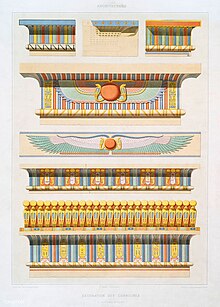

A cavetto is a concave moulding with a regular curved profile that is part of a circle, widely used in architecture as well as furniture, picture frames, metalwork and other decorative arts. In describing vessels and similar shapes in pottery, metalwork and related fields, "cavetto" may be used of a variety of concave curves running round objects. The word comes from Italian, as a diminutive of cave, from the Latin for "hollow" (it is the same root as cave).[1] A vernacular alternative is "cove", most often used where interior walls curve at the top to make a transition to the roof, or for "upside down" cavettos at the bases of elements.[2]
The cavetto moulding is the opposite of the convex, bulging, ovolo, which is equally common in the tradition of Western classical architecture. Both bring the surface forward, and are often combined with other elements of moulding. Usually they include a curve through about a quarter-circle (90°).[3] A concave moulding of about a full semi-circle is known as a "scotia".[4]
Only a minor element of decoration in classical architecture, the prominent cavetto cornice is a common feature of the ancient architecture of Egypt and the Ancient Near East.